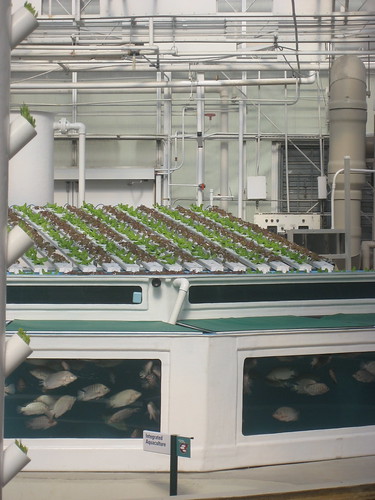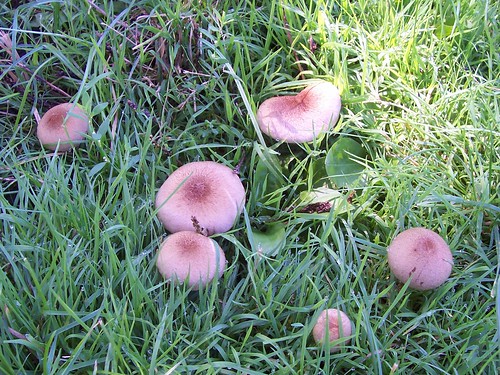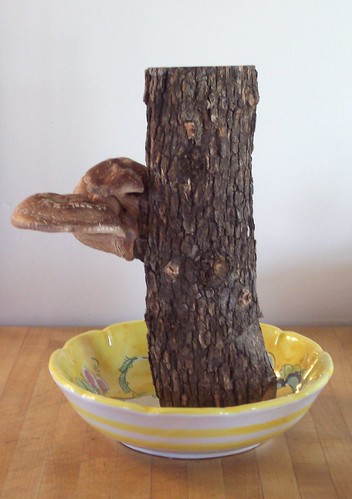Sunday, March 29, 2009
Hey Homeschoolers! I Need Your Help...
Thursday, March 19, 2009
Taxidermy at the Pember Museum

I've got a post up at GeekDad today about our trip earlier this week to the Pember Museum of Natural History in Granville, NY. It's a tiny one-room exhibit atop the public library, but I thought of its taxidermy collection when we were doing all that Darwin stuff. Links and more details at GeekDad.
Wednesday, March 18, 2009
Growing Fungi, Part 2
#1 – How long can a mushroom live?
The mushroom has a lifespan ranging from a few days, to hundreds of years. The lifespan depends heavily on how many neighboring mushrooms there are, the more neighbors, the longer the mushrooms live. The log that we bought says that the Shiitake mushrooms can last up to 4 years.
#2 – What are the symptoms of being poisoned by a mushroom?
Source-Wikipedia.com
Poisonous mushrooms contain a variety of different toxins that can differ markedly in toxicity. Symptoms of mushroom poisoning may vary from gastric upset to life-threatening organ failure resulting in death. Serious symptoms do not always occur immediately after eating; often not until the toxin attacks the kidney or liver, sometimes days or weeks later.
The most common consequence of mushroom poisoning is simply gastric upset. Most "poisonous" mushrooms contain gastrointestinal irritants which cause vomiting and diarrhea (sometimes requiring hospitalization), but no long-term damage. However, there are a number of recognized mushroom toxins with specific, and sometimes deadly, effects.
#3 – How many types of mushrooms are poisonous?
Tuesday, March 17, 2009
Disney Hydroponics
 This picture of hydroponic veggies in a fish tank is from the Homeschooled Twins blog. The family took a behind the scenes tour of a ride at Disney World in Florida called Living with the Land. Looks like a lot of fun!
This picture of hydroponic veggies in a fish tank is from the Homeschooled Twins blog. The family took a behind the scenes tour of a ride at Disney World in Florida called Living with the Land. Looks like a lot of fun!
Monday, March 16, 2009
Growing Fungi
A couple weeks ago, for biology, we sent away for a Shiitake-mushroom-growing kit. We have since grown (and eaten) a cluster of mushrooms. Some Q&A about mushrooms:
How can I tell which wild mushrooms are poisonous?
Contrary to popular belief, there is really no discerning characteristic that all poisonous mushrooms share. Since only about 5% of wild mushrooms are edible, I wouldn’t recommend eating a wild mushroom unless you are a hundred percent sure that it isn’t poisonous.
What is the life cycle of a mushroom?
(From ArticleClick.com)
Most mushrooms reproduce asexually by releasing thousands of spores through their gills into the open air for dispersion into the environment. Every spore is capable of germinating to create a new hypha. Hyphae are masses of intertwined filaments of cells which are the morphological unit of the fungus. When a thick mass of hyphae forms it is called mycelium or mycelia. Mushroom mycelium is usually white in color with a rough, cottony texture. Root like growth is called rhizomorphic.
When spores germinate they consume the water and nutrients from their environment and begin to reproduce. The medium that mushroom mycelium grows on is usually called substrate. Before the mushroom can start to form fruit bodies the mycelium colonizes the substrate fully and when the environmental conditions are right the mushroom emerges to produce more spores.
What different kinds of mushrooms are native to what areas?
Probably the most common edible mushroom, the Button Mushroom, is native to Europe (and North America.) The Portobello is also native to Europe and North America. The Shiitake is native to East Asia. The deadly Death Cap is native to Europe, North Africa, North America, Australia (SE), and New Zealand.

Mushroom Links:
Mushroom Life Cycle
Cornell University Virtual Library: Mycology
Lost Creek Mushroom Farm (supplier)
Fungi Perfecti (supplier)
Diagram of the mushroom life cycle.














